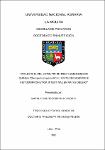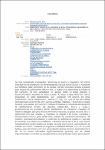Mostrar el registro sencillo del ítem
Influencia del consumo de tres variedades de quinua (Chenopodium quinoa Willds.) en tejido adiposo e histomorfometría intestinal en ratas obesas
| dc.contributor.advisor | Vilchez Perales, Niceas Carlos | |
| dc.contributor.author | Bernuy Osorio, Nataly Dolores | |
| dc.date.accessioned | 2018-11-06T15:17:08Z | |
| dc.date.available | 2018-11-06T15:17:08Z | |
| dc.date.issued | 2018 | |
| dc.identifier.other | S20.B47i-T BAN UNALM | |
| dc.identifier.uri | https://hdl.handle.net/20.500.12996/3637 | |
| dc.description | Universidad Nacional Agraria La Molina. Escuela de Posgrado. Doctorado en Nutrición | es_PE |
| dc.description.abstract | Se han encontrado compuestos bioactivos en frutas y vegetales con efecto favorable en la prevención de enfermedades crónicas como cáncer y Alzheimer que también están presentes en la quinua; siendo necesario realizar estudios para evaluar el potencial benéfico in vivo. El objetivo fue determinar la influencia del consumo de tres variedades de quinua sobre el tejido adiposo e histomorfometría intestinal en ratas obesas. 42 ratas obesas Holtzman fueron dispuestas en siete tratamientos. Con excepción del control, los otros tratamientos fueron alimentados, durante 23 días, con una de las seis dietas obesogénicas conteniendo 20% quinua variedad Altiplano, Pasankalla o Negra Collana, procesadas por cocción o tostado. Al finalizar el periodo de alimentación se determinaron niveles de glucosa, triglicéridos, HDL-c y VLDL-c; posteriormente los animales fueron sacrificados, se extrajeron muestras de intestino delgado (ID) para histomorfometría intestinal, la grasa visceral (GV) y abdominal (GA) fue pesada, y muestras de hígado e ID fueron extraídas y almacenadas (–20°C) para posteriores análisis de actividad antioxidante. Se midieron actividad antioxidante y contenido de polifenoles totales en quinuas procesadas. Los datos se sometieron a ANOVA utilizando el MLG bajo diseño completamente randomizado con arreglo factorial 3x2+Control y comparación de medias por Fisher mediante el programa estadístico Minitab v.17.1.0. El perfil lipídico, peso de riñones, GV, GA, peroxidación lipídica del ID e histomorfometría del ID no fueron afectados significativamente (p>0.05) por las dietas experimentales; sin embargo, el tratamiento control presentó mayor peroxidación lipídica en el hígado (p<0.05) y peso del ID (p<0.05) en comparación a los que contenían quinua procesada. En conclusión, la alimentación de ratas obesas con dietas que contienen variedades de quinua procesada no reduce el perfil lipídico, GV, GA, peroxidación lipídica del ID e histomorfometría del ID; sin embargo, reduce la peroxidación lipídica en el hígado. | es_PE |
| dc.description.abstract | Bioactive compounds have been found in fruits and vegetables with a favorable effect in the prevention of chronic diseases such as cancer and Alzheimer's which are also present in quinoa; being necessary to carry out studies to evaluate the beneficial potential in vivo. The objective was to determine the influence of the consumption of three varieties of quinoa on adipose tissue and intestinal histomorphometry in obese rats. Forty two obese Holtzman rats were divided into seven treatments. With exception of the control, the other treatments were fed, during 23 days, with one of the six obesogenic diets containing 20% quinoa variety Altiplano, Pasankalla or Negra Collana, processed by cooking or roasting. At the end of the feeding period, levels of glucose, triglycerides, HDL-c and VLDL-c were determined; subsequently the animals were sacrificed, small intestine (SI) samples were extracted for intestinal histomorphometry, visceral (VF) and abdominal fat (AF) were weighed, and liver and SI samples were extracted and stored (-20°C) for further analysis of antioxidant activity. Antioxidant activity and total polyphenol content were measured in the processed quinoa. Data were submitted to ANOVA using the MLG under completely randomized design with factorial arrangement 3x2+Control and comparison of means by Fisher through the statistical program Minitab v.17.1.0. The lipidic profile, weight of kidneys, VF, AF, lipid peroxidation of the SI and histomorphometry of the SI was not significantly affected (p>0.05) by the experimental diets; however, the control treatment presented greater lipid peroxidation in the liver (p<0.05) and weight of the SI (p<0.05) in comparison to those containing processed quinoa. In conclusion, feeding obese rats with diets containing varieties of processed quinoa does not reduce the lipidic profile, VF, AF, lipid peroxidation of the SI and histomorphometry of the SI; however, reduces lipid peroxidation in the liver. | en_US |
| dc.description.uri | Tesis | es_PE |
| dc.format | application/pdf | en_US |
| dc.language.iso | spa | es_PE |
| dc.publisher | Universidad Nacional Agraria La Molina | es_PE |
| dc.rights | info:eu-repo/semantics/openAccess | en_US |
| dc.rights.uri | https://creativecommons.org/licenses/by-nc-nd/4.0/ | * |
| dc.source | Universidad Nacional Agraria La Molina | es_PE |
| dc.source | Repositorio institucional - UNALM | es_PE |
| dc.subject | Rata | es_PE |
| dc.subject | Animales de laboratorio | es_PE |
| dc.subject | Chenopodium Quinoa | es_PE |
| dc.subject | Variedades | es_PE |
| dc.subject | Consumo de alimentos | es_PE |
| dc.subject | Composición química | es_PE |
| dc.subject | Tejido adiposo | es_PE |
| dc.subject | Sobrepeso | es_PE |
| dc.subject | Peroxidación lipídica | es_PE |
| dc.subject | Antioxidantes | es_PE |
| dc.subject | Análisis aproximado | es_PE |
| dc.subject | Experimentación in vivo | es_PE |
| dc.subject | Perú | es_PE |
| dc.subject | Quinua | es_PE |
| dc.subject | Histomorfometría instestinal | es_PE |
| dc.subject | Obesidad | es_PE |
| dc.title | Influencia del consumo de tres variedades de quinua (Chenopodium quinoa Willds.) en tejido adiposo e histomorfometría intestinal en ratas obesas | es_PE |
| dc.type | info:eu-repo/semantics/doctoralThesis | en_US |
| thesis.degree.discipline | Nutrición | es_PE |
| thesis.degree.grantor | Universidad Nacional Agraria La Molina. Escuela de Posgrado | es_PE |
| thesis.degree.name | Doctoris Philosophiae - Nutrición | es_PE |
| thesis.degree.level | Doctorado | es_PE |
| dc.subject.ocde | https://purl.org/pe-repo/ocde/ford#3.03.04 | es_PE |
Ficheros en el ítem
Este ítem aparece en la(s) siguiente(s) colección(ones)
-
D-NUT Tesis [12]




